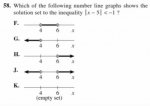I tried to add 5 to both sides to get... x<4.
But that isn't correct because x = 3 doesn't work; it's untrue that 2<-1.
Does this not work because it's an inequality? Although, I don't get why it wouldn't work.
To find the solution, it seems like you just have to use trial and error. Is that the only method of finding the solution?
But that isn't correct because x = 3 doesn't work; it's untrue that 2<-1.
Does this not work because it's an inequality? Although, I don't get why it wouldn't work.
To find the solution, it seems like you just have to use trial and error. Is that the only method of finding the solution?

